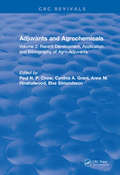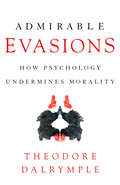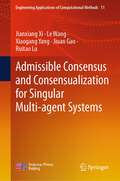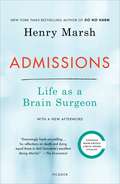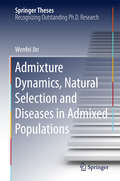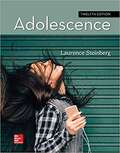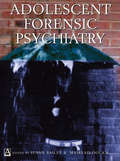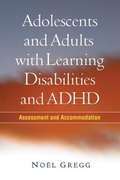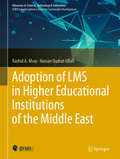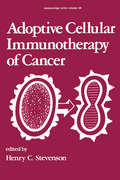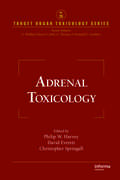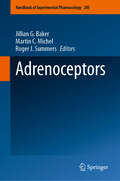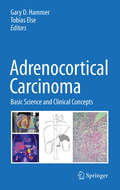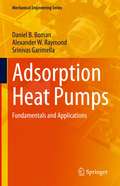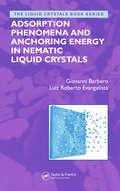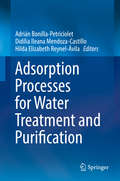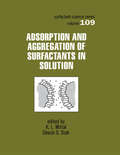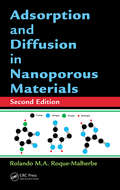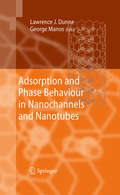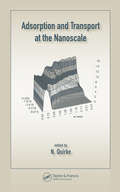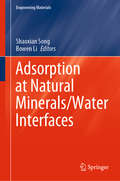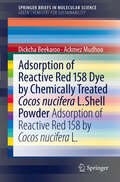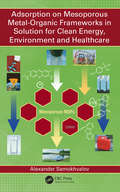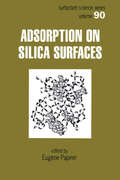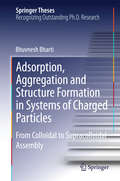- Table View
- List View
Adjuvants and Agrochemicals: Volume 2: Recent Development, Application, and Bibliography of Agro-Adjuvants
by Paul N. ChowStudies of Adjuvants involve many scientific fields from basic research of the chemistry, through investigations into physiological effects and environmental impact, to mixture formulation and field use. These important areas are illustrated in these two volumes, which are contributions from the First International Symposium on Adjuvants for Agrochemicals, held in Brandon, Manitoba on August 5 to 7, 1986. A total of 200 participants from 19 countries met to discuss their common interest in adjuvant science, technology, and application. It is the editors hope that these volumes will stimulate interest in and promote a better understanding of the chemical, physiological, and agronomic aspects of adjuvants as they relate agrochemicals. In addition, the revisedAdjuvants for Agrochemicals: A Selected Bibliography of World Literature in the English Language will be a valuable resource for agricultural researchers and other users. We hope that adjuvant research will lead to even safer, more efficient, and more economical use of chemicals in agriculture and forestry.
Admirable Evasions
by Theodore DalrympleIn Admirable Evasions, Theodore Dalrymple explains why human self-understanding has not been bettered by the false promises of the different schools of psychological thought. Most psychological explanations of human behavior are not only ludicrously inadequate oversimplifications, argues Dalrymple, they are socially harmful in that they allow those who believe in them to evade personal responsibility for their actions and to put the blame on a multitude of scapegoats: on their childhood, their genes, their neurochemistry, even on evolutionary pressures.Dalrymple reveals how the fashionable schools of psychoanalysis, behaviorism, modern neuroscience, and evolutionary psychology all prevent the kind of honest self-examination that is necessary to the formation of human character. Instead, they promote self-obsession without self-examination, and the gross overuse of medicines that affect the mind.Admirable Evasions also considers metaphysical objections to the assumptions of psychology, and suggests that literature is a far more illuminating window into the human condition than psychology could ever hope to be.
Admissible Consensus and Consensualization for Singular Multi-agent Systems (Engineering Applications of Computational Methods #11)
by Jianxiang Xi Le Wang Xiaogang Yang Jiuan Gao Ruitao LuThis book explores admissible consensus analysis and design problems concerning singular multi-agent systems, addressing various impact factors including time delays, external disturbances, switching topologies, protocol states, topology structures, and performance constraint. It also discusses the state-space decomposition method, a key technique that can decompose the motions of singular multi-agent systems into two parts: the relative motion and the whole motion. The relative motion is independent of the whole motion. Further, it describes the admissible consensus analysis and determination of the design criteria for different impact factors using the Lyapunov method, the linear matrix inequality tool, and the generalized Riccati equation method. This book is a valuable reference resource for graduate students of control theory and engineering and researchers in the field of multi-agent systems.
Admissions: Life as a Brain Surgeon
by Henry MarshThe International Bestseller"Consistently entertaining...Honesty is abundantly apparent here--a quality as rare and commendable in elite surgeons as one suspects it is in memoirists." —The Guardian"Disarmingly frank storytelling...his reflections on death and dying equal those in Atul Gawande's excellent Being Mortal." —The EconomistHenry Marsh has spent a lifetime operating on the surgical frontline. There have been exhilarating highs and devastating lows, but his love for the practice of neurosurgery has never wavered. Following the publication of his celebrated New York Times bestseller Do No Harm, Marsh retired from his full-time job in England to work pro bono in Ukraine and Nepal. In Admissions he describes the difficulties of working in these troubled, impoverished countries and the further insights it has given him into the practice of medicine. Marsh also faces up to the burden of responsibility that can come with trying to reduce human suffering. Unearthing memories of his early days as a medical student, and the experiences that shaped him as a young surgeon, he explores the difficulties of a profession that deals in probabilities rather than certainties, and where the overwhelming urge to prolong life can come at a tragic cost for patients and those who love them.Reflecting on what forty years of handling the human brain has taught him, Marsh finds a different purpose in life as he approaches the end of his professional career and a fresh understanding of what matters to us all in the end.
Admixture Dynamics, Natural Selection and Diseases in Admixed Populations (Springer Theses)
by Wenfei JinIn this thesis, Dr. Jin presents the distribution of ancestral chromosomal segments in the admixed genome, which could provide the information needed to explore population admixture dynamics. The author derives accurate population histories of African Americans and Mexicans using genome-wide single nucleotide polymorphisms (SNPs) data. Mapping the genetic background facilitates the study of natural selection in the admixed population, and the author identifies the signals of selection in African Americans since their African ancestors left for America. He further demonstrates that many of the selection signals were associated with African American-specific high-risk diseases such as prostate cancer and hypertension, suggesting an important role these disease-related genes might have played in adapting to their new environment. Lastly, the author reveals the complexity of natural selection in shaping human susceptibility to disease. The thesis significantly advances our understanding of the recent population admixture, adaptation to local environment and its health implications.
Adolescence
by Laurence SteinbergCutting-edge science, personalized for today’s students. <p><p> As a well-respected researcher, Laurence Steinberg connects current research with real-world application, helping students see the similarities and differences in adolescent development across different social, economic, and cultural backgrounds. <p><p> Through an integrated, personalized digital learning program, students gain the insight they need to study smarter, stay focused, and improve their performance.
Adolescent Forensic Psychiatry
by Susan Bailey Mairead DolanAdolescent Forensic Psychiatry discusses a broad range of issues based around the psychiatric needs of adolescents and how these relate to offending behaviour. Its well-structured approach looks at assessment, treatment and outcomes for different disorders and highlights the importance of effective interaction between specialist agencies. Services
Adolescents and Adults with Learning Disabilities and ADHD
by Noël GreggMost of the literature on learning disabilities and attention-deficit/hyperactivity disorder (ADHD) focuses on the needs of elementary school-age children, but older students with these conditions also require significant support. Comprehensive and authoritative, this book helps educators and clinicians navigate the maze of laws, policies, and scientific research relating to diagnostic and intervention decision making for adolescents and adults. Leading expert No\u00ebl Gregg provides clear guidance on how to conduct and document evidence-based assessments and select appropriate instructional and testing accommodations. Featuring helpful case vignettes, decision-making flowcharts, and coverage of the latest assistive technologies, the book gives special attention to supporting students during the crucial transition from high school to higher education or vocational settings.
Adoption of LMS in Higher Educational Institutions of the Middle East (Advances in Science, Technology & Innovation)
by Hassan Qudrat-Ullah Rashid A. KhanThis book discusses the adoption of learning management systems (LMS) in higher education institutions. It presents influential predictors that may impact instructors’ behavioral intention to adopt learning management systems in the context of Arab culture, as well as a unique model of technology acceptance that draws on and combines previous technology adoption models (i.e., a modified unified theory of acceptance and use of technology model – UTAUT2). Moreover, this study extends the UTAUT2 model by including Hofstede’s (1980) cultural dimensions, and technology awareness as the moderators of the model. It also describes the explanatory technique approach used to collect quantitative data from the instructors at higher education institutions in Saudi Arabia and were analyzed with structural equation modeling using SPSS/Amos software. The findings revealed that facilitating conditions were the strongest predictor of behavioral intention to adopt an LMS, followed by performance expectancy and hedonic motivation, technology awareness, and cultural dimensions exerted a moderating influence on instructors’ behavioral intention to use LMS in their teaching. By including new constructs, this becomes the first study of its kind exploring instructors’ use of LMS in Higher Educational Institutions of Saudi Arabia and other countries of the Middle East. It offers practical insights for a broad range of researchers and professionals at higher education institutions and serves as a reference guide for designers of learning management systems (e.g., blackboard systems), policymakers, and the Ministry of Education staff.
Adoptive Cellular Immunotherapy of Cancer
by H. C. StevensonThis volume presents the most complicated and powerful cancer biotherapies developed. It provides an overview of human immune system function and the mechanisms by which adoptive cellular immunotherapies (ACI) harnesses the activity. The volume provides a vision on the developments in ACI.
Adrenal Toxicology (Target Organ Toxicology Series)
by Philip W. Harvey David J. Everett Christopher J. SpringallDespite being regarded as the most common toxicological target in the endocrine system, the adrenal gland has often been neglected in regulatory testing. Adrenal Toxicology addresses the increased interest in adrenocortical toxicology and the need for a resource that makes techniques available to examine adrenal endocrine disruption. Examining curr
Adrenoceptors (Handbook of Experimental Pharmacology #285)
by Martin C. Michel Jillian G. Baker Roger J. SummersAdrenoceptors have been at the forefront of physiological and pharmacological research for a century. They served as prototypes for rationale drug design as recognized by a Nobel Prize to Sir James Black and for the molecular understanding and structure of G protein-coupled receptors as recognized by a Nobel Prize to Brian Kobilka and Robert J. Lefkowitz. Drugs directly or indirectly targeting adrenoceptors have become guideline-recommended treatments for more than 30 human and various animal diseases. This volume assembles leading experts on various types of adrenoceptor research to provide concise insight into the current standing and future direction of uses of adrenoceptor-targeted drugs and research in this field.
Adrenocortical Carcinoma: Basic Science and Clinical Concepts
by Gary D. Hammer Tobias ElseWe anticipate the book to be a definitive text on the subject that explores all aspects of the study of adrenal cancer and the treatment of patients with the disease. Chapters will cover epidemiology, pathogenesis, genetics, cancer stem cells, historic and emerging therapies, mouse models of adrenal cancer, new developments in tumor profiling, worldwide collaborative groups and tumor registries together with resources for the practitioner and community of adrenal cancer scientists. We do not wish this book to compete with the other larger books in the Endocrine and Endocrine Surgery literature. In addition, it is not expected to cover benign adrenal diseases that have been covered in detail in other venues. We envision this book to be a very specialized and exhaustive text on basic, translational and clinical aspects of adrenal cancer.
Adsorption Heat Pumps: Fundamentals and Applications (Mechanical Engineering Series)
by Daniel B. Boman Alexander W. Raymond Srinivas GarimellaThis volume introduces the fundamentals of adsorption heat pumps, beginning with the simplest cycle and building to the most complex. Selection of adsorbents and refrigerants, design of adsorption beds and auxiliary heat exchangers, and applications for different designs are all discussed. The book educates engineering students, engineers, and researchers about an environmentally friendly alternative to vapor compression refrigeration systems promising for many applications. The authors cover thermodynamic cycles, working materials for the cycles, and aspects of designing and modeling adsorption heat pumps.Elucidates the various applications of adsorption heat pumps;Illustrates modeling techniques for quickly screening new working materials early in their development;Provides comprehensive review of cycle types, with discussion of the applications for which they are best suited;Appropriate for graduate courses on advanced thermodynamics, design of thermal systems, sustainable energy technology, refrigeration technologies, and thermal control of electronics.
Adsorption Phenomena and Anchoring Energy in Nematic Liquid Crystals
by Giovanni Barbero Luiz Roberto EvangelistaDespite the large quantity of phenomenological information concerning the bulk properties of nematic phase liquid crystals, little is understood about the origin of the surface energy, particularly the surface, interfacial, and anchoring properties of liquid crystals that affect the performance of liquid crystal devices. Self-contained and unique,
Adsorption Processes for Water Treatment and Purification
by Adrián Bonilla-Petriciolet Didilia Ileana Mendoza-Castillo Hilda Elizabeth Reynel-ÁvilaThis book provides researchers and graduate students with an overview of the latest developments in and applications of adsorption processes for water treatment and purification. In particular, it covers current topics in connection with the modeling and design of adsorption processes, and the synthesis and application of cost-effective adsorbents for the removal of relevant aquatic pollutants. The book describes recent advances and alternatives to improve the performance and efficacy of this water purification technique. In addition, selected chapters are devoted to discussing the reliable modeling and analysis of adsorption data, which are relevant for real-life applications to industrial effluents and groundwater.
Adsorption and Aggregation of Surfactants in Solution
by K. L. Mittal; Dinesh 0. ShahOffering the latest research and developments in the understanding of surfactant behavior in solutions, this reference investigates the role and dynamics of surfactants and their solution properties in the formulation of paints, printing inks, paper coatings, pharmaceuticals, personal care products, cosmetics, liquid detergents, and lubricants. Exploring the science behind techniques from oil recovery to drug delivery, the book covers surfactant stabilized particles; solid particles at liquid interfaces; nanocapsules; aggregation behavior of surfactants; micellar catalysis; vesicles and liposomes; the clouding phenomena; viscoelasticity of micellar solutions; and more.
Adsorption and Diffusion in Nanoporous Materials
by Rolando Roque-MalherbeOffering a materials science point of view, the author covers the theory and practice of adsorption and diffusion applied to gases in microporous crystalline, mesoporous ordered, and micro/mesoporous amorphous materials. Examples used include microporous and mesoporous molecular sieves, amorphous silica, and alumina and active carbons, akaganeites, prussian blue analogues, metal organic frameworks and covalent organic frameworks. The use of single component adsorption, diffusion in the characterization of the adsorbent surface, pore volume, pore size distribution, and the study of the parameters characterizing single component transport processes in porous materials are detailed.
Adsorption and Phase Behaviour in Nanochannels and Nanotubes
by Lawrence J. Dunne George ManosChannels of nanotubular dimensions exist in a variety of materials (examples are carbon nanotubes and the nanotubular channels of zeolites and zeotypes) and show promise for numerous applications due to their unique properties. One of their most important properties is their capacity to adsorb molecules and these may exist in a variety of phases. "Adsorption and Phase Behaviour in Nanochannels and Nanotubes" provides an excellent review of recent and current work on adsorption on nanometerials. It is an impressive collection of papers dealing with the adsorption and phase behaviour in nanoporous materials from both experimental and theoretical perspectives. "Adsorption and Phase Behaviour in Nanochannels and Nanotubes" focuses on carbon nanotubes as well as zeolites and related materials.
Adsorption and Transport at the Nanoscale
by Nick QuirkeNanoporous materials are used widely in industry as adsorbents, particularly for applications where selective adsorption of one fluid component from a mixture is important. Nanoscale structures are of increasing interest for micro- and nanofluidic devices. Computational methods have an important role to play in characterizing, understanding, and de
Adsorption at Natural Minerals/Water Interfaces (Engineering Materials)
by Bowen Li Shaoxian SongThis book introduces the latest research regarding the adsorption of heavy metals, toxic ions, and organic compounds at the interfaces of water/minerals, such as mineralogical characterizations, surface chemistry, and modification of natural minerals as adsorbents, as well as the adsorption of cations, anions, and organic compounds in water. Presenting findings by the authors and their co-workers, the book helps readers grasp the principals and benefits of using minerals for water treatment, as well as the advanced technologies in the area developed over last 30 years, especially the last 10 years.
Adsorption of Reactive Red 158 Dye by Chemically Treated Cocos Nucifera L. Shell Powder: Adsorption of Reactive Red 158 by Cocos Nucifera L. (SpringerBriefs in Molecular Science)
by Ackmez Mudhoo Dickcha BeekarooThe effective removal of dyes from aqueous waste is an important issue for many industrialized countries. The traditional treatment methods used to remove dyes from wastewater have certain disadvantages such as incomplete dye removal, high reagent and energy requirements, and the generation of toxic sludge or other waste products that require disposal. The search for alternative and innovative treatment techniques has focused attention on the use of biological materials for dye removal and recovery technologies. This brief summarizes the latest developments in this important field.
Adsorption on Mesoporous Metal-Organic Frameworks in Solution for Clean Energy, Environment and Healthcare
by Alexander SamokhvalovAdsorption and desorption in solution play significant roles in separations, detoxification of waste streams, in purification, chromatography, heterogeneous catalysis, metabolism of medicinal drugs, and beyond. Metal-Organic Frameworks (MOFs) are well-ordered 3-dimensional hybrid organic-inorganic polymers which contain metal cations and the structure-building organic "linker" units. Mesoporous MOFs with pore sizes 2-50 nm are particularly suitable for adsorption and adsorption-based separations of large molecules of organic and bio-organic compounds. Thousands of organic compounds and, in particular, aromatic and heterocyclic compounds are widely used as feedstock for industrial chemical synthesis, as fine chemicals, major components of liquid fossil fuels, dyestuffs, industrial solvents, agricultural chemicals, medicinal drugs, pharmaceuticals and personal care products (PPCPs), and active pharmaceutical ingredients (APIs). There is a strong interest towards synthesis, characterization and studies of both known and newly synthesized mesoporous MOFs for adsorption in solution to achieve the high adsorption capacity, selectivity, and the possibility of multiple regeneration of "spent" sorbent. This book covers experimental fundamental research on using mesoporous MOFs in emerging applications of major industrial, environmental and academic importance, especially purification of water and liquid fossil fuels and in advanced biomedical technologies.
Adsorption on Silica Surfaces (Surfactant Science)
by Eugene Papirer"Progresses from theoretical issues to applications. Contains a historical overview, in-depth considerations of various scenarios of silica adsorption, and results from the latest research. Invaluable for broad coverage of the expanding field of silica research."
Adsorption, Aggregation and Structure Formation in Systems of Charged Particles: From Colloidal to Supracolloidal Assembly (Springer Theses)
by Bhuvnesh BhartiThis thesis presents studies on the interaction of soft materials like surfactants and proteins with hard silica nanomaterials. Due to its interdisciplinary nature it combines concepts from the fields of physical chemistry, nanoscience and materials science, yielding to fundamental insights into the structure-directing forces operating at the nano-scale. It is shown that the morphology of surfactant micellar aggregates adsorbed at the surface of nanoparticles and inside tubular nanopores can be tuned on demand by the co-adsorption of a surface modifier. The interaction of globular proteins with silica nanoparticles is dominated by electrostatic interactions and can be controlled by pH and ionic strength, while the bridging of nanoparticles by adsorbed protein molecules leads to large-scale hybrid aggregates of protein with the nanoparticles. Concepts emerging from the role of electrostatic interactions in the hetero-aggregation of nanoparticles with protein molecules are used for the co-assembly of charged microbeads into linear clusters and chains of controllable length.
